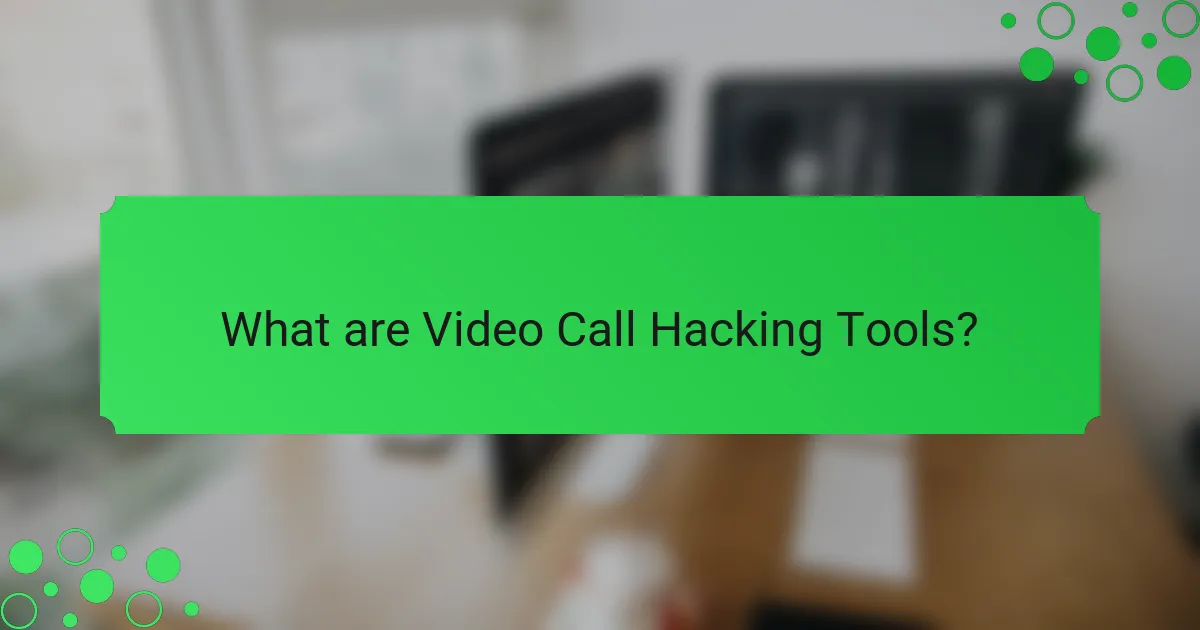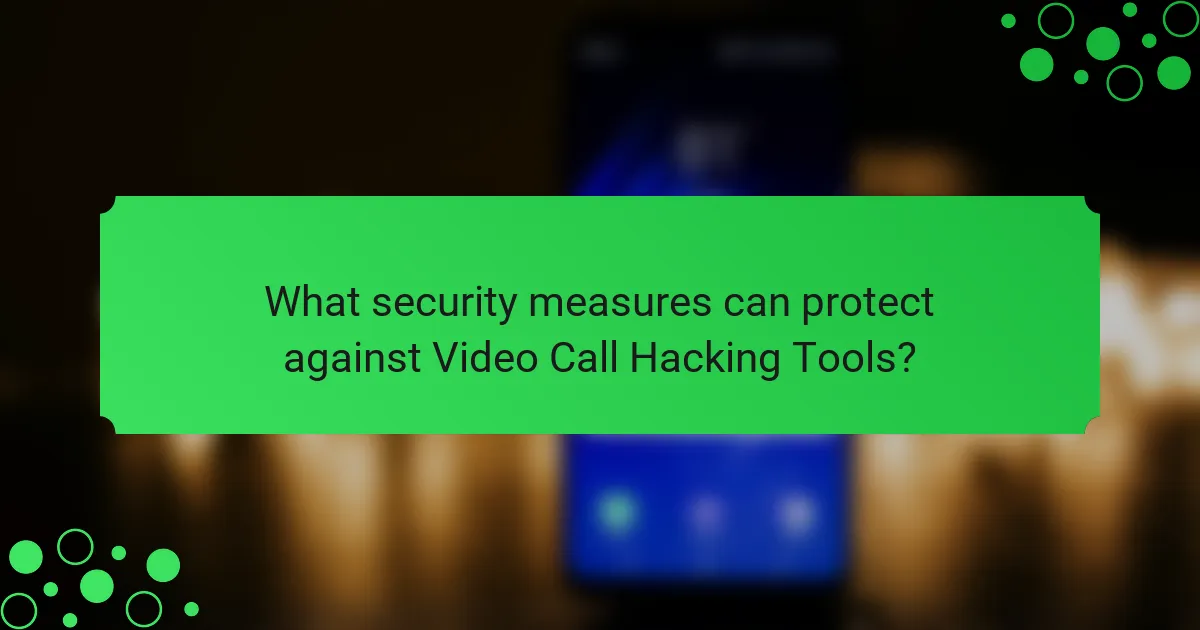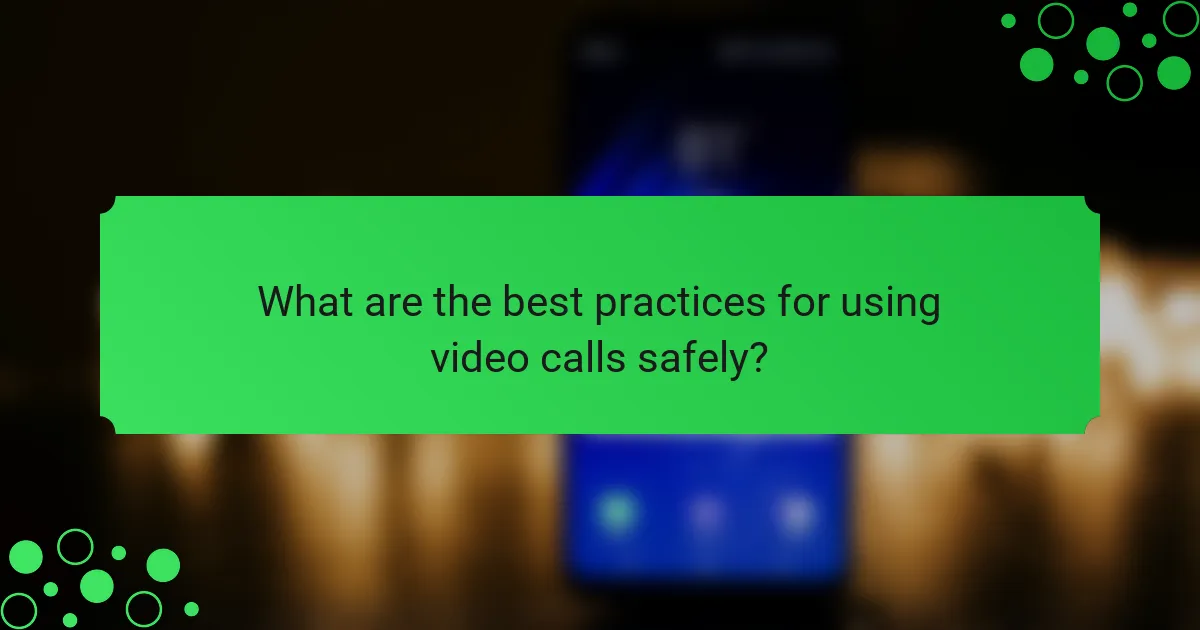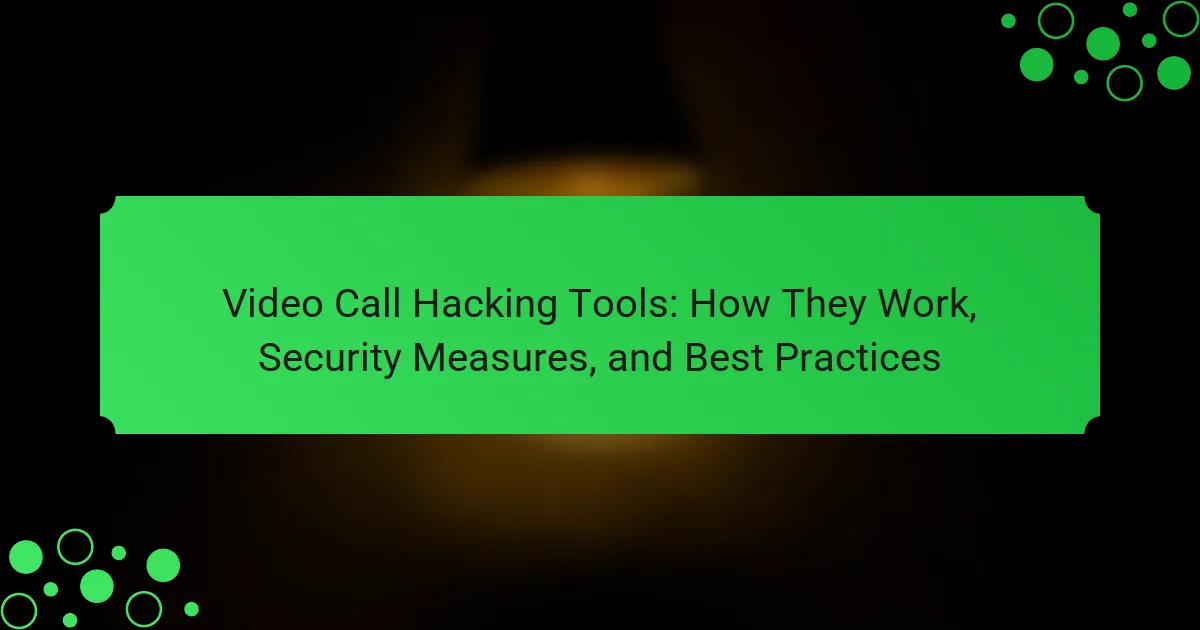Video call hacking tools are software or methods designed to gain unauthorized access to video conferencing platforms by exploiting vulnerabilities in software and network security. The article outlines various hacking techniques, including phishing, malware, and weak password exploitation, highlighting real-world instances of privacy breaches during virtual meetings. It emphasizes the necessity of implementing robust security measures, such as using strong passwords, enabling two-factor authentication, and regularly updating software to mitigate risks. Additional best practices include utilizing end-to-end encryption, limiting meeting access, and being cautious of suspicious communications. This comprehensive overview serves to inform readers about the threats posed by video call hacking tools and the essential steps to enhance security in virtual environments.

What are Video Call Hacking Tools?
Video call hacking tools are software or methods used to gain unauthorized access to video conferencing platforms. These tools exploit vulnerabilities in the software or network security. Common hacking techniques include phishing, malware, and exploiting weak passwords. Security experts have identified numerous instances where such tools have been used to breach privacy during virtual meetings. For example, a 2020 report by the Cybersecurity and Infrastructure Security Agency highlighted increased incidents of unauthorized access to video calls during the pandemic. This underscores the importance of robust security measures to protect against these threats.
How do Video Call Hacking Tools function?
Video call hacking tools function by exploiting vulnerabilities in video conferencing software. These tools can intercept data transmitted during calls. They often utilize techniques such as phishing to gain access to user credentials. Some tools can manipulate software settings to enable unauthorized access. Others may deploy malware to compromise devices used for video calls. Specific vulnerabilities in platforms like Zoom or Microsoft Teams can be targeted. For instance, unsecured links or outdated software can be exploited. Security experts recommend regular updates and awareness of phishing attempts to mitigate these risks.
What technologies are utilized in Video Call Hacking Tools?
Video call hacking tools utilize various technologies to exploit vulnerabilities in video conferencing platforms. These tools often employ malware to gain unauthorized access to devices. They may also use phishing techniques to trick users into revealing sensitive information. Network sniffing is another common technology, allowing hackers to intercept data packets during a video call. Additionally, some tools leverage social engineering tactics to manipulate individuals into granting access. Encryption weaknesses in video call software can also be targeted. These technologies enable hackers to compromise privacy and security during video communications.
How do these tools exploit vulnerabilities in video calls?
Video call hacking tools exploit vulnerabilities by intercepting data streams and manipulating software. They often target weak encryption protocols used in video conferencing applications. Attackers can use malware to gain unauthorized access to devices during calls. Phishing attacks can trick users into revealing sensitive information or downloading malicious software. Some tools exploit known software vulnerabilities to inject malicious code. They can also leverage social engineering tactics to gain user trust. According to a report by Cybersecurity & Infrastructure Security Agency (CISA), over 80% of video conferencing applications have reported vulnerabilities. This highlights the importance of implementing robust security measures to mitigate these risks.
Why are Video Call Hacking Tools a concern?
Video call hacking tools are a concern due to their potential to invade privacy and compromise security. These tools can allow unauthorized access to video calls, exposing sensitive information. For instance, hackers can eavesdrop on discussions or capture private images. The rise of remote work has increased the use of video conferencing, making these platforms attractive targets. According to a 2021 report by Cybersecurity Ventures, cybercrime costs are projected to reach $10.5 trillion annually by 2025. This highlights the urgency of addressing vulnerabilities in video call software. Inadequate security measures can lead to data breaches and loss of trust in communication platforms.
What are the potential risks associated with these tools?
Video call hacking tools pose several potential risks. These tools can facilitate unauthorized access to private conversations. They may lead to data breaches, exposing sensitive information. Users can experience identity theft through stolen credentials. Malware may be installed on devices, compromising security. Additionally, these tools can disrupt meetings, causing reputational damage. Organizations may face financial losses due to these security incidents. According to a report from Cybersecurity Ventures, cybercrime is projected to cost the world $10.5 trillion annually by 2025, highlighting the severity of such risks.
How can Video Call Hacking Tools impact personal privacy?
Video call hacking tools can significantly compromise personal privacy by allowing unauthorized access to video calls. These tools can intercept and record conversations without users’ knowledge. Hackers can exploit vulnerabilities in software to gain control over devices. This intrusion can lead to the exposure of sensitive information, such as personal discussions and confidential data. Research indicates that over 70% of video conferencing platforms have experienced security breaches. Consequently, users may find their private lives exposed to malicious actors. The impact on personal privacy can be profound, leading to identity theft and reputational damage.

What security measures can protect against Video Call Hacking Tools?
Use strong passwords for video call accounts. Passwords should be complex and unique. Enable two-factor authentication on video call platforms. This adds an extra layer of security. Regularly update video conferencing software to patch vulnerabilities. Software updates often include security enhancements. Be cautious of suspicious links or emails related to video calls. Phishing attempts can lead to unauthorized access. Utilize end-to-end encryption when available. This ensures that only participants can access the call content. Limit meeting access to invited participants only. Use waiting rooms to control entry into meetings.
How can users enhance their video call security?
Users can enhance their video call security by implementing strong password protection. They should use unique, complex passwords for each video conferencing platform. Enabling two-factor authentication adds an additional layer of security. Users should also ensure that software is up to date to protect against vulnerabilities. Utilizing end-to-end encryption can safeguard the privacy of conversations. Users should be cautious about sharing meeting links and avoid posting them publicly. Limiting screen sharing to trusted participants helps prevent unauthorized access. Finally, using a virtual private network (VPN) can secure internet connections during video calls.
What role do encryption and authentication play in video call security?
Encryption and authentication are critical for ensuring video call security. Encryption protects the data transmitted during the call by converting it into a secure format. This prevents unauthorized access and eavesdropping. Authentication verifies the identities of the participants in the call. It ensures that only authorized users can join the conversation.
According to a study by the National Institute of Standards and Technology, encryption can significantly reduce the risk of data breaches. Additionally, strong authentication methods, like multi-factor authentication, further enhance security. These measures collectively create a secure environment for video communication.
How can software updates help mitigate hacking risks?
Software updates can help mitigate hacking risks by fixing vulnerabilities in the software. These updates often include patches that address security flaws discovered after the software’s initial release. For example, in 2020, Microsoft released updates that fixed over 100 vulnerabilities, including critical ones that could allow remote code execution. Regular updates also enhance software features and improve overall security protocols. By keeping software up to date, users can protect themselves against known threats. Cybersecurity experts recommend updating software as soon as updates are available. This practice significantly reduces the chances of exploitation by hackers.
What organizational strategies can be implemented for video call security?
Implementing organizational strategies for video call security involves multiple layers of protection. First, enforce strong password policies for all video conferencing accounts. This includes requiring complex passwords that are changed regularly. Second, utilize end-to-end encryption for all video calls to ensure data privacy. According to a study by the Cybersecurity and Infrastructure Security Agency, encryption significantly reduces the risk of unauthorized access. Third, train employees on recognizing phishing attempts and securing their devices. Regular training sessions can increase awareness and reduce security breaches. Fourth, limit access to video calls by using waiting rooms and password protections. This prevents unauthorized participants from joining meetings. Lastly, regularly update video conferencing software to patch vulnerabilities. Keeping software up to date is crucial, as outdated systems are more susceptible to attacks. These strategies collectively enhance the security of video calls within an organization.
How can companies train employees to recognize video call threats?
Companies can train employees to recognize video call threats through targeted training programs. These programs should include identifying common threats such as phishing attempts and unauthorized access. Employees should learn to recognize suspicious behaviors, like uninvited participants or unusual requests during calls. Regular simulations of video call scenarios can enhance recognition skills. Additionally, providing guidelines on verifying participant identities can be effective. Training should also emphasize the importance of reporting suspicious activities. Research indicates that 90% of security breaches involve human error, highlighting the need for effective training. Continuous education on evolving threats is essential for maintaining awareness.
What policies should organizations establish to safeguard video communications?
Organizations should establish policies that enforce secure access controls for video communications. These policies should include mandatory authentication protocols, such as two-factor authentication, to ensure only authorized users can access video calls. Additionally, organizations must implement encryption for all video communications to protect data from interception. Regular training sessions should be conducted to educate employees on recognizing phishing attempts and securing their devices. Policies should also mandate the use of secure networks, discouraging the use of public Wi-Fi for sensitive communications. Regular audits and compliance checks should be established to assess adherence to these policies. Furthermore, organizations should define clear guidelines for recording and storing video calls to protect sensitive information.

What are the best practices for using video calls safely?
Use strong passwords for video call accounts. Passwords should include a mix of letters, numbers, and symbols. Enable two-factor authentication for added security. This requires a second form of verification. Use a secure internet connection, preferably a VPN. Public Wi-Fi can expose your calls to hackers. Keep software updated to protect against vulnerabilities. Regular updates patch security flaws. Limit meeting access to invited participants only. Use waiting rooms to screen attendees before they join. Be cautious about sharing personal information during calls. Avoid discussing sensitive topics in unsecured environments.
How can users ensure secure video call environments?
Users can ensure secure video call environments by implementing several key practices. First, they should use strong, unique passwords for video conferencing accounts. This prevents unauthorized access. Second, enabling two-factor authentication adds an extra layer of security. It requires a second form of verification, making it harder for intruders to gain entry. Third, users should always update their video conferencing software. Updates often contain security patches that protect against vulnerabilities. Fourth, they should utilize end-to-end encryption if available. This ensures that only participants can access the video and audio streams. Additionally, users should be cautious about sharing meeting links. They should avoid posting links publicly to minimize the risk of unwanted participants. Lastly, using a virtual private network (VPN) can enhance security by encrypting internet traffic. These measures collectively help create a secure environment for video calls.
What tools and settings should be utilized for secure video calls?
Utilize end-to-end encrypted video conferencing tools for secure video calls. Tools like Zoom, Microsoft Teams, and Signal offer strong encryption. Enable password protection for meetings to restrict access. Use two-factor authentication for added security during login. Adjust privacy settings to limit screen sharing and recording options. Regularly update software to patch vulnerabilities. Educate participants about phishing attacks to prevent unauthorized access. These measures collectively enhance the security of video calls.
How can users verify the authenticity of video call participants?
Users can verify the authenticity of video call participants by using several methods. First, they should check the video quality and clarity. Poor quality can indicate manipulation or a fake call. Second, users can ask participants to perform specific actions, like showing a physical object, to confirm their identity. Third, utilizing video conferencing platforms with built-in security features, such as encryption and participant verification, enhances authenticity. Fourth, users can cross-check the participant’s identity through another communication channel. For example, sending a text message or making a phone call can confirm the identity of the person on the video call. These methods collectively provide a reliable way to ensure that participants are who they claim to be.
What common mistakes should be avoided during video calls?
Common mistakes to avoid during video calls include poor lighting, background distractions, and technical issues. Poor lighting can make it difficult for participants to see you clearly. A cluttered or distracting background can divert attention from the conversation. Technical issues, such as unstable internet connections, can disrupt communication. Additionally, not muting when not speaking can lead to background noise. Failing to test equipment beforehand can result in delays. Ignoring the camera can make interactions feel less personal. Lastly, multitasking during the call can diminish engagement and focus.
How can oversharing information lead to security breaches?
Oversharing information can lead to security breaches by providing unauthorized access to sensitive data. When individuals disclose personal or confidential information publicly, it creates opportunities for malicious actors. For example, sharing details about security protocols or personal identifiers can facilitate identity theft. According to a 2020 study by the Identity Theft Resource Center, 33% of data breaches were due to human error, including oversharing. This highlights the need for caution in information sharing. Cybercriminals often exploit oversharing to craft targeted phishing attacks. Thus, maintaining privacy is crucial to prevent potential security threats.
What precautions should be taken when using public networks for video calls?
Use a virtual private network (VPN) when making video calls on public networks. A VPN encrypts your internet connection, protecting your data from potential eavesdroppers. Ensure the VPN is reputable and has strong encryption protocols. Avoid accessing sensitive information during calls, as public networks are less secure. Use updated security software on your device to protect against malware. Limit the use of public Wi-Fi for video calls whenever possible. Instead, opt for mobile data or a secured private network. Always log out of applications after use to prevent unauthorized access.
What are the latest trends in video call security technologies?
The latest trends in video call security technologies include end-to-end encryption, AI-driven threat detection, and secure access controls. End-to-end encryption ensures that only participants can access the video call content. AI-driven threat detection systems analyze user behavior to identify and mitigate potential security breaches. Secure access controls, such as multi-factor authentication, add an additional layer of protection for users. According to a 2023 report by Cybersecurity Ventures, video conferencing software with these features has seen a 60% reduction in unauthorized access incidents. These advancements reflect the growing emphasis on privacy and data security in remote communication.
How are artificial intelligence and machine learning enhancing video call security?
Artificial intelligence and machine learning enhance video call security by detecting anomalies and preventing unauthorized access. AI algorithms analyze user behavior patterns in real time. They identify deviations that may indicate potential security threats. Machine learning models are trained on vast datasets to recognize common attack vectors. This enables proactive threat detection before breaches occur. Additionally, AI can encrypt video streams dynamically based on risk assessment. According to a study by Cybersecurity Ventures, AI can reduce security incidents by up to 30%. This demonstrates the effectiveness of AI and machine learning in securing video calls.
What emerging tools are available to combat video call hacking?
Emerging tools available to combat video call hacking include end-to-end encryption software, advanced authentication methods, and AI-driven security solutions. End-to-end encryption ensures that only participants can access the call content, preventing unauthorized access. Advanced authentication methods, such as multi-factor authentication, add an extra layer of security by requiring additional verification steps. AI-driven security solutions can detect unusual activity during calls, alerting users to potential hacking attempts. These tools are essential as video conferencing usage has surged, increasing the risk of cyber threats. According to a report by Cybersecurity Ventures, video conferencing software is a top target for hackers, highlighting the need for robust security measures.
What are practical tips for maintaining video call security?
Use unique meeting IDs for each video call. This prevents unauthorized access to your sessions. Enable waiting rooms to control who joins the call. This feature allows you to vet participants before they enter. Always use strong, complex passwords for meetings. This adds an extra layer of security against intruders. Limit screen sharing to hosts only. This helps prevent accidental exposure of sensitive information. Regularly update your video conferencing software. Updates often include security patches that protect against vulnerabilities. Be cautious with links and attachments shared during calls. Malicious content can compromise your device’s security. Finally, educate participants about security practices. Awareness can significantly reduce the risk of breaches.
Video call hacking tools are software or methods designed to gain unauthorized access to video conferencing platforms, exploiting vulnerabilities in security protocols. This article outlines how these tools function, the technologies they utilize, and the potential risks they pose to personal privacy and organizational security. It also discusses effective security measures, best practices for users, and emerging trends in video call security technologies, emphasizing the importance of robust protective strategies against cyber threats in remote communication.
